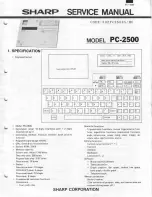
|
10
KeyRIg 49 User Guide
To select an alternate function:
1. Press the Edit Mode button.
2. Press the black key that represents the function you want to assign to the Octave buttons. KeyRig 49 will exit Edit
mode as soon as you push one of these keys
PLEASE NOTE:
Some of the functions that the Octave buttons can be used for cannot
send out a value less than zero. When used to control these functions, both lights above the
buttons will remain on, regardless of the current setting of that function.
The available functions of the octave buttons are:
Octave Shift
The Octave “<” and “>” buttons control octave shift by default. However, if these keys have been programmed to control
another function, you may wish to re-assign them to control octave shift once again
To assign the Octave “<” and “>” buttons to control octave shift:
1. Press the Edit Mode button.
2. Press the black key above C1 (C#1), representing DATA = OCTAVE. KeyRig 49 will exit Edit mode as soon as C#1
has been pressed
Another method of shifting KeyRig 49’s octaves is with the use of the black keys labeled OCTAVE “+,” “-,” and “0” on the
Advanced Functions in Edit Mode diagram. This octave shift method can be useful when the Octave buttons have been
reassigned to control another MIDI function.
1. Press the Edit Mode button.
2. Press the black key below B2 (Bb2). In Edit mode, this key functions as “,” shifting the keyboard up one
octave. It is possible to shift the keyboard up a total of four octaves.
3. Press the black key above F2 (F#2). In Edit mode, this key functions as “OCTAVE -,” shifting the keyboard down one
octave. It is possible to shift the keyboard down a total of three octaves.
4. Press the black key above G2 (G#2). In Edit mode, this key functions as “OCTAVE 0” to reset the octave shift to zero.
5. When you have chosen your octave shift, either press C5 representing “ENTER,” or press the Edit Mode button to exit
Edit mode.
Transpose
In some cases it is useful to increase or decrease the transmitted pitch by a small number of semitones rather than a whole
octave. For example, you may be playing a song with a singer and the singer is having trouble hitting the high notes. In this
case, you can try reducing the pitch by one or more semitones. This is achieved using a function called “Transpose.”
Transpose works similar to octave shift, except the shift is not limited to multiples of 12 semi-tones. As with octave shift, there
are two ways of transposing the keyboard. When in Edit mode, you can assign the Octave “<” and “>” buttons to control the
transpose feature. Alternatively, you can use the black keys F#3, G#3, and Bb3 to shift the transposition. These black keys
represent “TRANSPOSE -,” “TRANSPOSE 0” and “TRA” respectively.
To assign the Octave “<” and “>” buttons to transpose:
1. Press the Edit Mode button.
2. Press the black key above D1 (D#1), representing “DATA = TRANSPOSE.” KeyRig will exit Edit mode as soon as
D#1 has been pressed.
When the Octave buttons are assigned to transpose the keyboard, the lights above the buttons indicate the direction
of the transposition. To return the keyboard’s transpose shift to zero, press both the Octave “<” and “>” buttons at the
same time










































